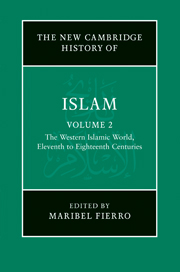Book contents
- Frontmatter
- Introduction
- PART I AL-ANDALUS AND NORTH AND WEST AFRICA (ELEVENTH TO FIFTEENTH CENTURIES)
- PART II EGYPT AND SYRIA (ELEVENTH CENTURY UNTIL THE OTTOMAN CONQUEST)
- PART III MUSLIM ANATOLIA AND THE OTTOMAN EMPIRE
- PART IV NORTH AND WEST AFRICA (SIXTEENTH TO EIGHTEENTH CENTURIES)
- PART V RULERS, SOLDIERS, PEASANTS, SCHOLARS AND TRADERS
- 19 State formation and organisation
- 20 Conversion to Islam: from the ‘age of conversions’ to the millet system
- 21 Taxation and armies
- 22 Trade
- 22A Muslim trade in the late medieval Mediterranean world
- 22B Overland trade in the western Islamic world (fifth–ninth/eleventh–fifteenth centuries)
- 22C Trade in the Ottoman lands to 1215/1800
- 23 The ʿulamāʾ
- Glossary
- Bibliography
- Index
- References
22A - Muslim trade in the late medieval Mediterranean world
from 22 - Trade
Published online by Cambridge University Press: 28 March 2011
- Frontmatter
- Introduction
- PART I AL-ANDALUS AND NORTH AND WEST AFRICA (ELEVENTH TO FIFTEENTH CENTURIES)
- PART II EGYPT AND SYRIA (ELEVENTH CENTURY UNTIL THE OTTOMAN CONQUEST)
- PART III MUSLIM ANATOLIA AND THE OTTOMAN EMPIRE
- PART IV NORTH AND WEST AFRICA (SIXTEENTH TO EIGHTEENTH CENTURIES)
- PART V RULERS, SOLDIERS, PEASANTS, SCHOLARS AND TRADERS
- 19 State formation and organisation
- 20 Conversion to Islam: from the ‘age of conversions’ to the millet system
- 21 Taxation and armies
- 22 Trade
- 22A Muslim trade in the late medieval Mediterranean world
- 22B Overland trade in the western Islamic world (fifth–ninth/eleventh–fifteenth centuries)
- 22C Trade in the Ottoman lands to 1215/1800
- 23 The ʿulamāʾ
- Glossary
- Bibliography
- Index
- References
Summary
Introduction
Muslim trade in the Mediterranean world was strikingly different in the later medieval period than it had been in earlier centuries. During the fifth/eleventh century, control of Mediterranean shipping and commerce began to shift from Muslim to Christian hands as a result of crusade, conquest and the growth of the European economy. In the earlier medieval period, Muslim regions of the Mediterranean had been integrated by commerce and communications, even when they were politically divided under the rule of different dynasties. By the sixth/twelfth century, however, warfare and territorial losses had eroded earlier Muslim commercial networks, while new European markets and merchants had emerged on the scene. Muslim trade continued in North Africa and Naṣrid Granada, as well as in some Christian Mediterranean ports, but the challenges to commerce and communications, and new political and religious divisions, forced Muslim merchants to shift their business affairs and routes of trade.
Although Islamic merchants and ships did not disappear from the Mediterranean during the later medieval period, data on Muslim merchants become scarcer than in earlier centuries, and it is clear that their activities became more restricted. Ifrīqiya ceased to be an important hub for Muslim merchant traffic by the sixth/twelfth century as their commercial activity increasingly focused on Egypt and eastern Islamic lands.
- Type
- Chapter
- Information
- The New Cambridge History of Islam , pp. 632 - 647Publisher: Cambridge University PressPrint publication year: 2010

